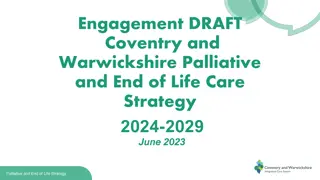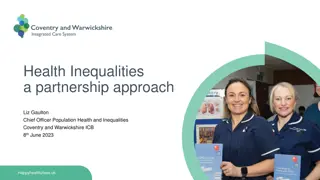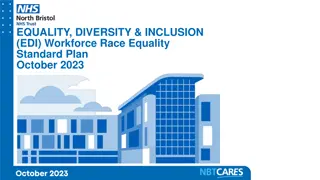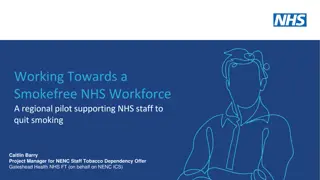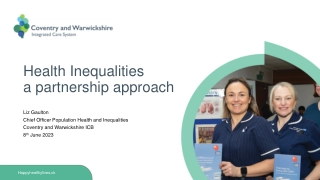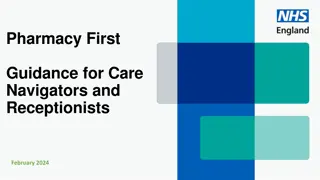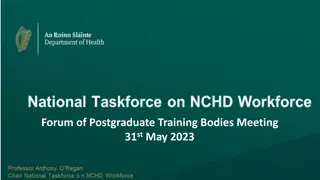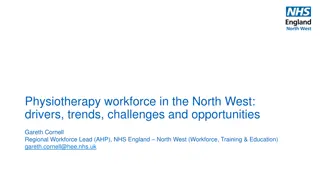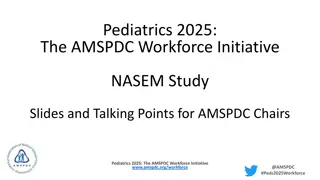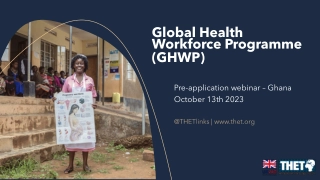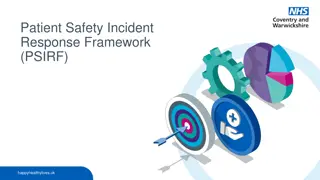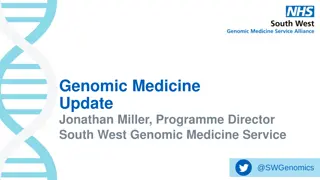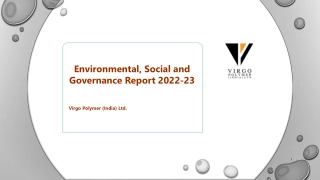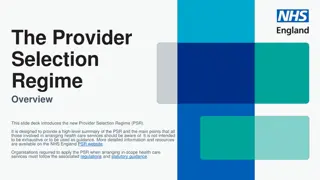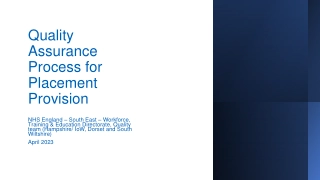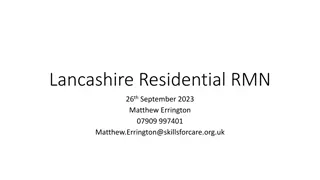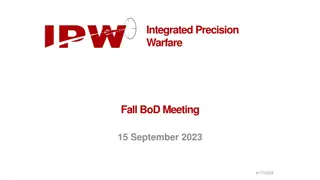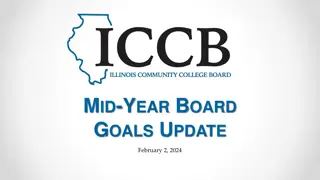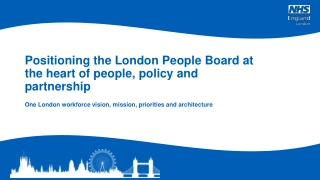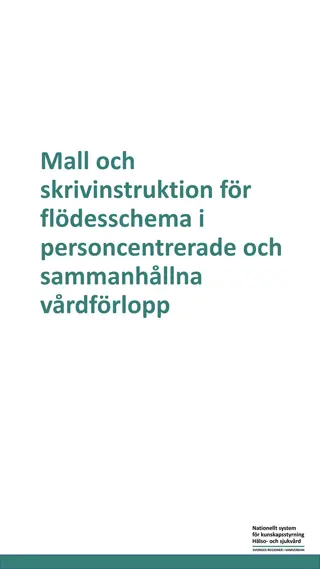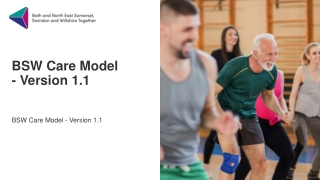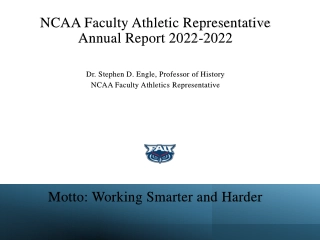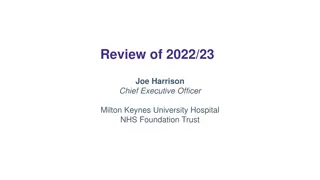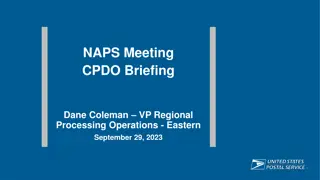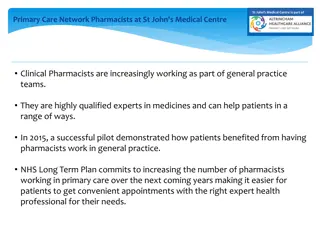NHS Coventry and Warwickshire Integrated Care Board Workforce Race Equality Standard Report 2022-2023
This report presents the findings of the Workforce Race Equality Standard (WRES) for the NHS Coventry and Warwickshire Integrated Care Board for the year 2022-2023. It outlines key indicators, action plans, and commitments to drive change towards racial equality in the workplace, focusing on data analysis, diversity promotion, and inclusive practices.
NHS Coventry and Warwickshire Integrated Care Board Workforce Race Equality Standard Report 2022-2023
PowerPoint presentation about 'NHS Coventry and Warwickshire Integrated Care Board Workforce Race Equality Standard Report 2022-2023'. This presentation describes the topic on This report presents the findings of the Workforce Race Equality Standard (WRES) for the NHS Coventry and Warwickshire Integrated Care Board for the year 2022-2023. It outlines key indicators, action plans, and commitments to drive change towards racial equality in the workplace, focusing on data analysis, diversity promotion, and inclusive practices.. Download this presentation absolutely free.
Presentation Transcript
Organisation: NHS Coventry and Warwickshire Integrated Care Board Workforce Race Equality Standard (WRES) Report 2022 2023 - Redacted Prepared by: Mojisola Green, Arden and GEM CSU Equality, Inclusion and Human Rights Senior Manager Ali Abdoul, Arden and GEM CSU Equality, Inclusion and Human Rights Project Manager Date: July 2023 Name and Title of Board Lead: Theresa Nelson, Chief People Officer happyhealthylives.uk
Contents Introduction The Nine WRES Indicators Key Findings Summary of WRES Outcomes 2022-2023 WRES Report - 2022-23 Indicators 1-9 WRES Action Plan for 2023-2026 Further Information and Contact Details Page 3 Page 4 Page 5 Page 6 Pages 7-15 Page 16 Page 17 happyhealthylives.uk
Introduction Workforce Race Equality Standard (WRES) 2022 The workforce data and findings within this report are a snapshot of the NHS Coventry and Warwickshire ICB (CWICB) on 31st March 2023. The NHS Workforce Race EqualityStandard (WRES) came into effect in the NHS in 2015 and was mandated for Trusts. In 2019, the requirement changed and the WRES is now mandated for ICBs. The purpose of the WRES is to help NHS organisations to review their equality data against 9 WRES indicators and to produce action plans which will facilitate the closure of gaps in outcomes and experience evidenced in the NHS workplace (as a whole) between White and Black and Minority Ethnic (BME) staff, as well as help to improve BME representation at Board Level. Ultimately, it is about ensuring an inclusive approach with regards to recruitment, training and promotion. NHS Coventry and Warwickshire ICB is committed to have due regard to the WRES and uses it as a force for driving change, both as an employer and commissioner of services. The ICB aims to fully understand the diversity of the workforce so that it can ensure non-discriminatory practice, work with staff and staff representatives to identify and eliminate barriers and discrimination in line with the Public Sector Equality Duty, the Equality Act 2010 and Employment Statutory Code of Practice. The Action Plan sets out the actions CWICBhas planned to undertake to fulfil its commitment to the WRES for the period 2023-2024. This has been developed, based on the WRES information the ICB has collated and analysed, while ensuring a useful and effective approach to tackling race equality across the ICB place is promoted and maintained. It is recommended that the Governing Body of NHS Coventry and Warwickshire ICB notes and approves the information contained in this report and the action plan prior to publication on the ICB website by 31 October 2023. Note on redacted data: Where the numbers of staff (or associated identifying data) for a category are below five the detail has been redacted. This is to ensure anonymity and that individual members of staff cannot be easily identified. The numbers less than five are represented in the data by the symbol - . This does not mean that there were zero numbers rather that they are less than five. If there were no counts at all the number zero would be kept in the data. happyhealthylives.uk
The Nine Workforce Race Equality Standard Indicators The nine indicators were developed in collaboration with the wider NHS. Four focus on workforce data and four are based on data from the national NHS Staff Survey questions. The last indicator focuses upon ethnic minority background representation on boards. These are detailed in the table below: 1-4 Workforce indicators: For each of these four workforce Indicators, compare the data for white and BME staff Indicator 1 Percentage of staff in each of the AfC Bands 1-9 or Medical and Dental subgroups and VSM (including Executive Board members) compared with the percentage of staff in the overall workforce disaggregated by: Non-Clinical staff; Clinical staff - of which Non-Medical staff, Medical and Dental staff Indicator 2 Indicator 3 Relative likelihood of staff being appointed from shortlisting across all posts Relative likelihood of staff entering the formal disciplinary process, as measured by entry into a formal disciplinary investigation Indicator 4 National NHS Staff Survey indicators (or equivalent): For each of the four staff survey indicators, compare the outcomes of the responses for white and BME staff Relative likelihood of staff accessing non-mandatory training and CPD Indicator 5 Indicator 6 Indicator 7 Percentage of staff experiencing harassment, bullying or abuse from patients, relatives or the public in last 12 months Percentage of staff experiencing harassment, bullying or abuse from staff in last 12 months Percentage believing that trust provides equal opportunities for career progression or promotion Indicator 8 In the last 12 months have you personally experienced discrimination at work from manager/team leader or other colleagues? Board representation indicator: For this indicator, compare the difference for white and BME staff Indicator 9 Percentage difference between the organisations Board membership and its overall workforce disaggregated: By voting membership of the Board By executive membership of the Board happyhealthylives.uk
Key Findings 2022-23 *x1.78 20% 0.88 X3.89 6.7% BME staff were 3.89 times more likely to enter the formal disciplinary process than white staff. This is an increase from 1.09 in 2021-22 As at 31 March 2023, 20% (87) of staff working in the organisation were from a black and minority ethnic background. This is compare to 22.89% (84) in 2022 There is a significant improvement in the likelihood of BME staff accessing non- mandatory training and CPD from 1.43 in 2021- 22 to 0.88 in 2022-23. White applicants were 1.78 times more likely to be appointed from shortlisting compared to BME applicants; this is an improvement on 2021-22 at 2.20. Compared to last year the levels of staff who had personally experienced discrimination at work from a manager, team leader or other colleagues has increased for both BME staff 2.2% increase from 4.5% to 6.7% and White staff 2.3% increase from 2.2% to 4.5%. Monitor that grievance and disciplinary policies and processes are accessible ensure they are applied fairly. Maintain robust inclusive recruitment and selection practices Regular monitoring & reviewing of work force demographics Record all formal & non-formal mandatory training Consolidate and the strengthen the Freedom to Speak Up Guardian service. 33.3% 66% 14.9% 21.3% 38.30% 33.3 % of board members in NHS Coventry and Warwickshire ICB were from a BME background in 2022-23. This is less representative than 41.7% in 2021-22 The NHS Coventry and Warwickshire ICB response rate for the 2022 NHS Staff Survey. This is an increase from 64% in 2021 NHS Staff Survey Compared to last year there has been a reduction of 3.7% from 18.6% to 14.9% of staff from BME background experienced harassment, bullying or abuse from patient, relative or the public in the last 12 months Compared to last year there has been a significant increase of 5% from 16.3% to 21.3% of staff from BME background experienced harassment, bullying or abuse from staff in the last 12 months Compared to last year there has been an increase of 1.9% from 36.4% to 38.3% of staff from BME background who believed that there were equal opportunities for career progression or promotion. Continue to promote the importance of reporting unreasonable behaviour Explore Embed Civility and Respect into EDI training /learning opportunities Encourage staff to take part in the NHS staff survey Ensure a Talent management scheme is in place opportunities to further increase board diversity happyhealthylives.uk
Summary of WRES for 2022-2023 Overall, 96.59% of staff reported their ethnicity as at 31 March 2023. As at 31 March 2023, the total number of staff is 440, 87 (20%) of whom are from a BME background. This is lower than the Coventry population at 34.50% BME but higher than the Warwickshire s at 10.90% BME, and is representative of the total population for both Coventry and Warwickshire at 20%. RAG Rating Change Indicator 2022-2023 Summary 2021-2022 2022-2023 1 Bands 1-7 BME staff increased by 3% in clinical staff; decreased by 6.5% in non-clinical. Bands 8a-VSM no change in BME clinical staff; increased by 1% in non-clinical. In comparison to last year Band 1-7 BME decreased by 4%; while in band 8-VSM BME decreased by 1%. Overall, there has been a decrease of 3% for BME staff. Developing Developing 2 In 2022-23, overall, for NHS Coventry & Warwickshire ICB , White candidates were 1.78 times more likely than BME candidates to be appointed from shortlisting compared to BME applicants; this is better than 2021-22 at 2.20. Developing Developing 3 The relative likelihood of BME staff entering the formal disciplinary process is 3.89, which means BME staff are 3.89 times more likely than white staff to enter formal disciplinary processes. This is an increase from 1.09 in 2021-22 Underdevel oped Developing 4 There is a significant improvement in the likelihood of BME staff accessing non-mandatory training and CPD from 1.43 in 2021- 22 to 0.88 in 2022-23. Developing Achieving 5 14.9% of BME staff experienced harassment bullying or abuse from patients, relatives or public in the last 12 months, which is significantly above the national average at 8.3%. Under Developed Developing 6 21.3% of BME staff experienced harassment, bulling or abuse from staff in last 12 months, which is above the national average at 20.0%. Under Developed Developing 7 38.3% of BME staff believe that the ICB provides equal opportunities for career progression, which is equal to the national average at 38.3%. Developing Developing 8 6.7% of BME staff experience discrimination at work from manager/team leader or other colleagues in the last 12 months, which is lower than the national average at 13.3%. Developing Developing 9 In 2022-23 the data for the ICB s Governing Body show a higher proportion of BME representation 33.3% than the overall workforce at 20%. happyhealthylives.uk Achieving Achieving
Indicator 1 Data Total number and percentage of staff by ethnicity as of March 2023 Coventry & Warwickshire ICB workforce as of 31 March 2023 77% 20% 3% Total number of staff 338 87 15 72% 23% 5% Band 8a -VSM 126 40 9 80% 18% 2% Band 1-7 212 47 6 0% 10% 20% 30% 40% 50% 60% 70% 80% 90% 100% White BME Do not wish to declare (Unknown) The overall population of Coventry and Warwickshire ICB place amounts to 942,100 people with 345,300 in Coventry and 596,800 in Warwickshire. 20% BME and 80% White. In Coventry 34.50% BME, 65.50% White. In Warwickshire 10.90% BME, 89.10% White. Overall, the representation of BME staff (20%) is lower than the Coventry BME population (34.50%), and higher than the Warwickshire BME population (10.90%) and is representative of the total population for both Coventry and Warwickshire at 20%. happyhealthylives.uk
Indicator 1 Data Percentage of staff in each of the AfC Bands 1-9 and VSM (including executive Board members) compared with the percentage of staff in the overall workforce disaggregated by: Non-Clinical Staff/Clinical staff Developing Coventry & Warwickshire ICB 2022/23 Comparison: Clinical Coventry & Warwickshire ICB 2022/23 Comparison: Clinical Band 1 - 7 (2022) Band 1 - 7 (2023) Band 8a - VSM (2022) Band 8a - VSM (2023) Band 8a - VSM (2023) 44 26 6 Band 8a - VSM (2022) White 46 80% 53 80% 44 57% 44 58% 44 26 7 BME 7 12% 10 15% 26 34% 26 34% Band 1 - 7 (2023) 53 10 3 Not disclosed - - - - 7 9% 6 8% Band 1 - 7 (2022) 46 7 4 Total - - 77 76 0% 20% 40% 60% 80% 100% White BME Not disclosed Coventry & Warwickshire ICB 2022/23 Comparison: Non-clinical Coventry & Warwickshire ICB 2022/23 Comparison: Non- clinical Band 1 - 7 (2022) Band 1 - 7 (2023) Band 8a - VSM (2022) Band 8a - VSM (2023) Band 8a - VSM (2023) 82 14 3 White 118 75% 159 80% 61 87% 82 83% Band 8a - VSM (2022) 61 9 0 BME 40 25% 37 18.50% 9 13% 14 14% Band 1 - 7 (2023) 159 37 3 Not disclosed 0 0.00% - - 0 0.00% - - Band 1 - 7 (2022) 118 40 0 Total 158 - 70 - 0% 20% 40% 60% 80% 100% White BME Not disclosed happyhealthylives.uk
Indicator 1 Note on redacted data: Where the numbers of staff (or associated identifying data) for a category are below five the detail has been redacted. This is to ensure anonymity and that individual members of staff cannot be easily identified. The numbers less than five are represented in the data by the symbol - . This does not mean that there were zero numbers rather that they are less than five. If there were no counts at all the number zero would be kept in the data. Clinical: 80% of staff in band 1-7 are White; while 15% are BME; 5% of staff ethnicity is unknown 58% of staff in band 8a-VSM are White; 34% are BME, 8% of staff ethnicity is unknown Non-clinical: 80% of staff in band 1-7 are White; 18.50% are BME, 0.00% of staff ethnicity is unknown 83% of staff in band 8a-VSM are White; 14% are BME, 0.00% of staff ethnicity is unknown What is the data telling us? Bands 1-7 BME staff increased by 3% in clinical staff; decreased by 6.5% in non-clinical. Bands 8a-VSM there has been no change in BME clinical staff; increased by 1% in non-clinical staff In comparison to last year Band 1-7 BME decreased by 4%; while in band 8-VSM BME decreased by 1% Whilst there has been an increase of the total number of BME staff, we still need to be cautious. There has not been an increase in representation despite recruitment and increase of overall staff. The representation of BME dropped from 23% in 2022 to 20% in 2023. What have we done over the last year? Continued to ensure data on ESR is accurate and up to date Provided support for the ICB's staff EDI Network WRES report published on website What are we planning for 2023-24 Regularly monitor and review BME workforce demographics and set appropriate/relevant improvement Key Performance Measures (KPI s) Promote the importance of declaring equality information through regular communications and campaigns. Beginning with the application stage and throughout the employee journey. Encourage staff at all levels, and board members to regularly update their equality and diversity information on ESR. happyhealthylives.uk
Indicator 2 Relative likelihood of BME staff being appointed from shortlisting compared to that of white staff being appointed from shortlisting across all posts Developing Relative likelihood of appointment from shortlisting NHS Coventry & Warwickshire ICB 2021- 2022 NHS Coventry & Warwickshire ICB 2022-2023 Indicator 2: Recruitment 300 70.00% 62.50% 241 242 60.00% 250 Ethnicity White BME White BME 50.00% 200 174 40.00% Number of Staff in workforce 35.54% 150 269 82 338 87 30.00% 90 27.80% 25% 86 100 12.64% 20.00% 20% 67 Number shortlisted applicants 50 10.00% 241 174 242 90 22 18 8 12 5 3 0 0.00% Number appointed applicants White BME Undisclosed White BME Undisclosed 67 22 86 18 2022 2023 Relative likelihood of White candidates being appointed from shortlisting compared to BME candidates Number of shortlisted applicants 2.2 1.78 Number appointed from shortlisting Relative likelihood of appointment from shortlisting What is the data telling us? In 2022-23, overall for NHS Coventry & Warwickshire ICB , White candidates were 1.78 times more likely than BME candidates to be appointed from shortlisting. This is an improvement from 2.2 in 2022. There has been an improvement for all groups, particularly those undisclosed. This emphasises the importance of increasing declaration rates at the beginning of the recruitment process. What are we planning for 2023-24? Continue to ensure the ICB has robust inclusive, attraction, recruitment and selection practices, and that all the interview panels have gone through robust recruitment and selection training including unconscious bias training. Provide candidate feedback to identify areas of further work. Produce an action plan to improve and increase the attraction, recruitment and retention of staff and Board members who are BAME and/or with a disability, and ensure that employees from these backgrounds have equal access to career opportunities and receive fair treatment in the workplace. happyhealthylives.uk
Indicator 3 Relative likelihood of staff entering the formal disciplinary process, as measured by entry into a formal disciplinary investigation (This indicator will be based on data from a two year rolling average of the current year and previous year) Under Developed What is the data telling us? During 2022-2023, the number of formal disciplinary cases for BME staff was the same as last year and fewer than n=5 and are too small to identify any trends (n=<5 are represented by - ). Compared to last year there is a decrease overall in the number of staff entering formal disciplinary. However, BME staff are 3.89 more likely than white staff to enter the formal disciplinary processes. This is an increase from 1.09 in 2021-22 What have we done over the last year? Quarterly workforce reports produced which allowed the CQGC cttee to check and challenge the amount of any complaint What are we planning for 2022-23 Monitor that the grievance and disciplinary policiesand processes are accessible to staff and ensure they are applied fairly. Engage with the staff Equality, Diversity and InclusionNetwork to capture and improve BAME staff experiences in the workplace. A fair experience for all: Closing the ethnicity gap in rates of disciplinary action across the NHS workforce (england.nhs.uk) NHS Coventry and Warwickshire ICB 2021-22 2022-23 Indicator 3: Disciplinary Process White BME White BME Number of staff in workforce 269 82 338 87 Number of staff entering formal disciplinary - - - 6 Likelihood of White staff entering formal disciplinary 2.23% 0.59% Likelihood of BME staff entering formal disciplinary 2.44% 2.30% The relative likelihood of BME staff entering formal disciplinary compared to White staff 1.09 3.89 happyhealthylives.uk
Indicator 4:Relative likelihood of staff accessing non-mandatory training and CPD Achieving What is the data telling us? The data shows that the number of staff accessing non- mandatory training and CPD has decreased, compared to last year. There is a significant improvement in the likelihood of BME staff accessing non-mandatory training and CPD from 1.43 in 2021-22 to 0.88 in 2022-23. Indicator 4: Accessing non- mandatory training & CPD NHS Coventry & Warwickshire ICB 2021-2022 NHS Coventry & Warwickshire ICB 2022-2023 Ethnicity White BME White BME Number of Staff accessing non-mandatory training & CPD What have we done over the last year? 239 51 34 10 What are we planning for 2023-24 Likelihood of staff accessing non-mandatory training & CPD 88.85% 62.20% 10.06% 11.49% Continue to publicise non-mandatory training and CPD programmes to all staff The ICB will review and implement the process for recording and reporting non-mandatory training and CPD and monitor it on a regular basis. Review and implement a Talent Management Programme derived from e.g. Appraisals / Training Needs Analysis with focus on ensuring fair representation and access Relative likelihood of White staff accessing non-mandatory training & CPD compared to BME staff 1.43 0.88 happyhealthylives.uk
Indicator 5-6 National NHS Staff Survey Indicators 2022 Under developed Summary of 2022 Staff Survey outcomes (WRES Indicators 5-6) What is the data telling us? 14.9% of BME staff said they experienced harassment bullying or abuse from patients, relatives or the public in the last 12 months. Whilst this is an improvement of 3.7% on last year, it is nearly double the national average at 8.3%. 21.3% of BME staff said they experienced harassment, bullying or abuse from staff in last 12 months. This is an increase of 5% from 16.3% last year . It is also above the national average at 20.0% for BME staff. Coventry & Warwickshire ICB 2021 2022 Of the total who responded those who said Yes : White: 180 responses BME: 43 responses Of the total who responded those who said Yes : White: 199 responses BME: 47 responses 5 Percentage of staff experiencing harassment, bullying or abuse from patients, relatives or the public in last 12 months White: 18.3% BME: 18.6% White: 17.6% BME: 14.9% What have we done over the last year? Communications encouraging staff to complete the staff survey. Promotion of the importance and process for reporting unreasonable behaviourtowards staff from services users and from other staff and/or managers. Responses Responses National Average for ICBs: White: 9.7% BME: 9.8% National Average for ICBs: White: 7.9% BME: 8.3% Of the total who responded those who said Yes : White: 181 responses BME: 43 responses Of the total who responded those who said Yes : White: 201 responses BME: 47 responses What are we planning for 2023-24? Consolidate and the strengthen the Freedom to Speak Up Guardian service and promote and encourage it s use by staff. Improve reporting and recording of bullying and harassment cases and outcomes and include diversity information within the metrics. Embed Civility and Respect into Equality diversity and Inclusion training /learningopportunities. 6 Percentage of staff experiencing harassment, bullying or abuse from staff in last 12 months White: 17.4% BME: 21.3% White: 18.8% BME: 16.3% Responses Responses National Average for ICBs: White:13.6% BME: 20.6% National Average for ICBs: White: 15.5% BME:20% happyhealthylives.uk
Indicator 7-8 National NHS Staff Survey Indicators 2022-2023 What is the data telling us? There has been an increase in the number of BME staff believe that the ICB provides equal opportunities for career progression from 36.4% to 38.3%. This is the same as the national average of 38.3% There has been an increase in the number of BME staff who had personally experienced discrimination at work from manager etc. from 4.5% in 2021 to 6.7% in 2022. Whilst this is significantly below the national average at 13.3% it is still important to monitor this worsening trend. What have we done over the last year? Developing Coventry & Warwickshire ICB Summary of 2022 Staff Survey outcomes (WRES Indicators 7-8) 2021-22 2022-23 Of the total who responded those who said Yes : White: 180 responses BME: (44) responses White: 56.7% BME: 36.4% Responses National Average for ICBs: White: 65.7% BME: 36.5% Of the total who responded those who said Yes : 179 responses BME: 44 responses Of the total who responded those who said Yes : White: 201 responses BME: 47 responses White: 61.2% BME: 38.3% Responses National Average for ICBs: White: 59.3% BME:38.3% Of the total who responded those who said Yes : White: 198 responses BME: 45 responses 7 percentage believing that the ICB provides equal opportunities for career progression or promotion What are we planning for 2022-23? Outcomes of the Local Staff Survey are to be addressed through actions built into and implemented through the ICBs People plan Promotion of the importance and process for reporting unreasonable behaviourtowardsstaff from services users and from other staff and/or managers Review and implement a Talent Management Programme derived from e.g. Appraisals / Training Needs Analysis with focus on ensuring fair representation and access Programme of training to be developed for all managers on how and when to have regular caring conversations for example in 1-2-1s and appraisals as standard practice. 8 In the last 12 months have you personally experienced discrimination at work from any of the following: Manager, Team Leader, Other Colleagues White: 2.2% BME : 4.5% Responses National Average for ICBs: White: 4.7% BME: 12.7% White: 4.5% BME : 6.7% Responses National Average for ICBs: White: 4.5% BME: 13.3% happyhealthylives.uk
Indicator 9 Percentage difference between (i) the organisations Board voting membership and its overall workforce and (ii) the organisations Board executive membership and its overall workforce Coventry & Warwickshire ICB 2021-22 Coventry & Warwickshire ICB 2022-23 Achieving % GB / Board Workforce GB / Board Workforce % Difference Difference White 7 58.3% 269 74.3% -16% 7 58.3% 338 77% -18.5% BME - - 82 22.7% +19% - 33% 87 20% +13.6% Not disclosed 0 0.0% 11 3% -3% - 8.3% 15 3% +4.9% Total - 362 440 What is the data telling us? The data for Coventry & Warwickshire ICB s Governing Body shows a higher proportion of BME representation than the overall workforce. This is broadly representative of the local Coventry BME population at 34.50%, higher than the Warwickshire BME population at 10.90% and higher than the total BME population for both Coventry and Warwickshire at 20%. What have we done over the last year? What are we planning for 2022-2 Deliver Governing EDI in an ICB training for board members and senior leaders All Committee Chairs are to put into place governance measures to demonstrate assurance that Due Regard of Equality considerations, outcomes and decisions are discussed and recorded within Committee Minutes Address the 3% not disclosed ethnicity by Governing Body Members Continue to monitor and review Governing Body to Workforce demographic ratio regularly and set appropriate/relevant improvement Key Performance Measures (KPI s) aligned to e.g. A Model Employer: Increasing black and minority ethnic representation at senior levels across the NHS happyhealthylives.uk
RAG status key Achieving Action Planned for 2023-2024 Developing Underdeveloped IndicatorSix High Impact action RAG Theme Action Lead Date 1, 9 High Impact Action 2: Embed fair and inclusive recruitment processes and talent management strategies that target under- representation and lack of diversity Regularly monitor and review BME workforce demographics and set appropriate/relevant improvement Key Performance Measures (KPI s) Promote the importance of declaring equality information through regular communications and campaigns. Beginning with the application stage and throughout the employee journey. Encourage staff at all levels, and board members to regularly update their equality and diversity information on ESR. Review progress quarterly Workforce Data and Quantitative Intelligence Felicity Davies 2 High Impact Action 2: Embed fair and inclusive recruitment processes and talent management strategies that target under- representation and lack of diversity Recruitment, Retention Progression Continue to ensure the ICB has robust inclusive, attraction, recruitment and selection practices, and that all the interview panels have gone through robust recruitment and selection training including unconscious bias training. Provide candidate feedback to identify areas of further work. Produce an action plan to improve and increase the attraction, recruitment and retention of staff and Board members who are BAME and/or with a disability, and ensure that employees from these backgrounds have equal access to career opportunities and receive fair treatment in the workplace. End March 2024 Felicity Davies 3 High Impact Action 6: Create an environment that eliminates the conditions in which bullying, discrimination, harassment and physical violence at work occur. High Impact Action 3: Develop and implement an improvement plan to eliminate pay gaps Health and Wellbeing Leadership and Culture Monitor that the grievance and disciplinary policies and processes are accessible to staff and ensure they are applied fairly. Monitor FTSU concerns to identify key areas. Bring ICB values and behaviours to life through personal pledges EDI refresh and awareness training to senior leadership Review Quarterly Felicity Davies 4 Staff Engagement Continue to publicise non-mandatory training and CPD programmes to all staff Review and refresh flexible working policy to mitigate barriers Review Quarterly Felicity Davies 5, 6,8 High Impact Action 6: Create an environment that eliminates the conditions in which bullying, discrimination, harassment and physical violence at work occur. Health and Well being Consolidate and the strengthen the Freedom to Speak Up Guardian service and promote and encourage it s use by staff. Improve reporting and recording of bullying and harassment cases and outcome, and include diversity information within the metrics. Embed Civility and Respect into Equality diversity and Inclusion training /learning opportunities. Bring ICB values and behaviours to life through personal pledges Review data from NHS Staff Survey and Datix Felicity Davies Review Quarterly 7 Leadership and Culture Review and implement a Talent Management Programme derived from e.g. Appraisals / Training Needs Analysis with focus on ensuring fair representation and access Programme of training to be developed for all managers on how and when to have regular caring conversations for example in 1-2-1s and appraisals as standard practice. Review of staff network membership to ensure that representation is reflective of the ICB s workforce profile and local population in which they work or live. including a clear governance structure to ensure accountability and action is implemented. High Impact Action 4: Develop and implement an improvement plan to address health inequalities within the workforce. Felicity Davies Review Quarterly NHS England NHS equality, diversity, and inclusion improvement plan happyhealthylives.uk
To know more If you would like to discuss any element of this report, please contact: Executive Sponsor: TBC OR: EIHR Team: agcsu.equality@nhs.net happyhealthylives.uk


